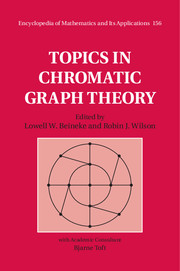Book contents
- Frontmatter
- Contents
- Foreword
- Preface
- Preliminaries
- 1 Colouring graphs on surfaces
- 2 Brooks's theorem
- 3 Chromatic polynomials
- 4 Hadwiger's conjecture
- 5 Edge-colourings
- 6 List-colourings
- 7 Perfect graphs
- 8 Geometric graphs
- 9 Integer flows and orientations
- 10 Colouring random graphs
- 11 Hypergraph colouring
- 12 Chromatic scheduling
- 13 Graph colouring algorithms
- 14 Colouring games
- 15 Unsolved graph colouring problems
- Notes on contributors
- Index
- References
4 - Hadwiger's conjecture
Published online by Cambridge University Press: 05 May 2015
- Frontmatter
- Contents
- Foreword
- Preface
- Preliminaries
- 1 Colouring graphs on surfaces
- 2 Brooks's theorem
- 3 Chromatic polynomials
- 4 Hadwiger's conjecture
- 5 Edge-colourings
- 6 List-colourings
- 7 Perfect graphs
- 8 Geometric graphs
- 9 Integer flows and orientations
- 10 Colouring random graphs
- 11 Hypergraph colouring
- 12 Chromatic scheduling
- 13 Graph colouring algorithms
- 14 Colouring games
- 15 Unsolved graph colouring problems
- Notes on contributors
- Index
- References
Summary
Hadwiger's conjecture states that any graph that does not have the complete graph Kk as a minor is (k − 1)-colourable. It is well known that the case k = 5 is equivalent to the four-colour theorem. In 1993 Robertson, Seymour and Thomas proved that the case k = 6 is also equivalent to the four-colour theorem. For k ≥ 7, the conjecture is still open. Our main focus in this chapter is to present recent results related to minimal counter-examples to Hadwiger's conjecture and some variations. We also consider algorithmic aspects of the conjecture and some of its variants, including the list-colouring version (which is false), the odd case of the conjecture, Hajós's conjecture and totally odd subdivisions, and Hadwiger's conjecture for some special classes of graphs.
Introduction
This chapter is motivated by Hadwiger's conjecture from 1943, which suggests a farreaching generalization of the four-colour theorem. It is among the most challenging open problems in all of graph theory.
Hadwiger's conjecture (strong version) For all k, every k-colourable graph contains the complete graph Kk as a minor.
For k ≤ 3, Hadwiger's conjecture is easy to prove, and for k = 4, it was proved independently by Hadwiger himself [31] and Dirac [21]. For k = 5, however, it becomes extremely difficult. In 1937 Wagner [74] proved that this case is equivalent to the four-colour theorem, so, given that result in [2], [3], [56], it follows that the case k = 5 also holds. In the deepest theorem in this area so far, Robertson, Seymour and Thomas [62] proved in 1993 that a minimal counter-example to the case k = 6 must have a vertex whose removal leaves a planar graph, so this case too follows from the four-colour theorem. For k ≥ 7, the conjecture is still open. For k = 7, Kawarabayashi and Toft [46] proved that every 7-chromatic graph has K7 or K4,4 as a minor, and recently Kawarabayashi [38] proved that every 7-chromatic graph has K7 or K3,5 as a minor.
Information
- Type
- Chapter
- Information
- Topics in Chromatic Graph Theory , pp. 73 - 93Publisher: Cambridge University PressPrint publication year: 2015
